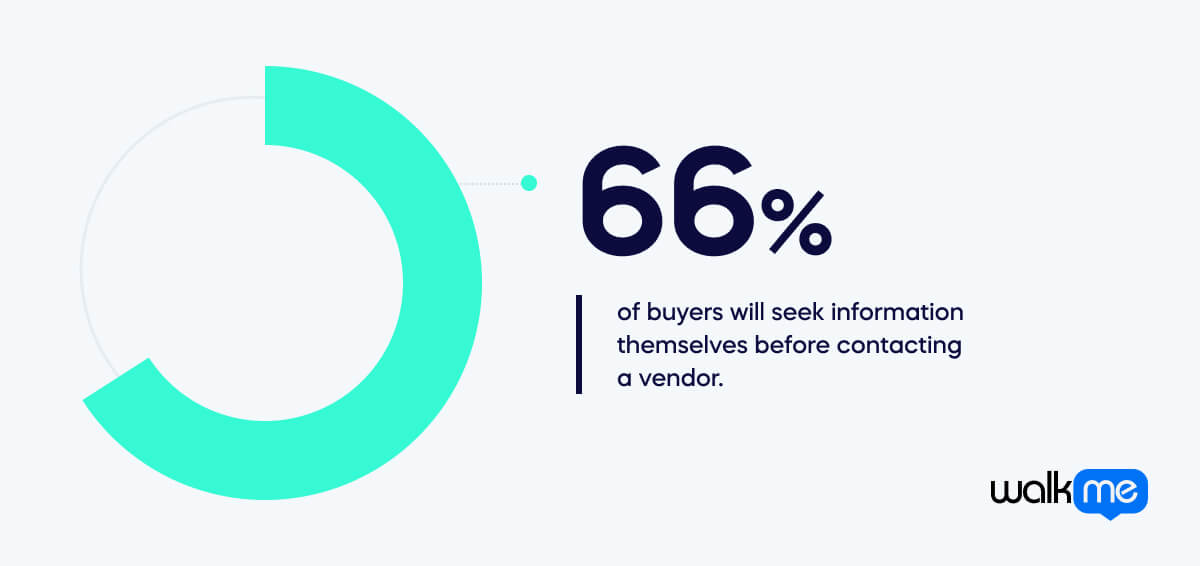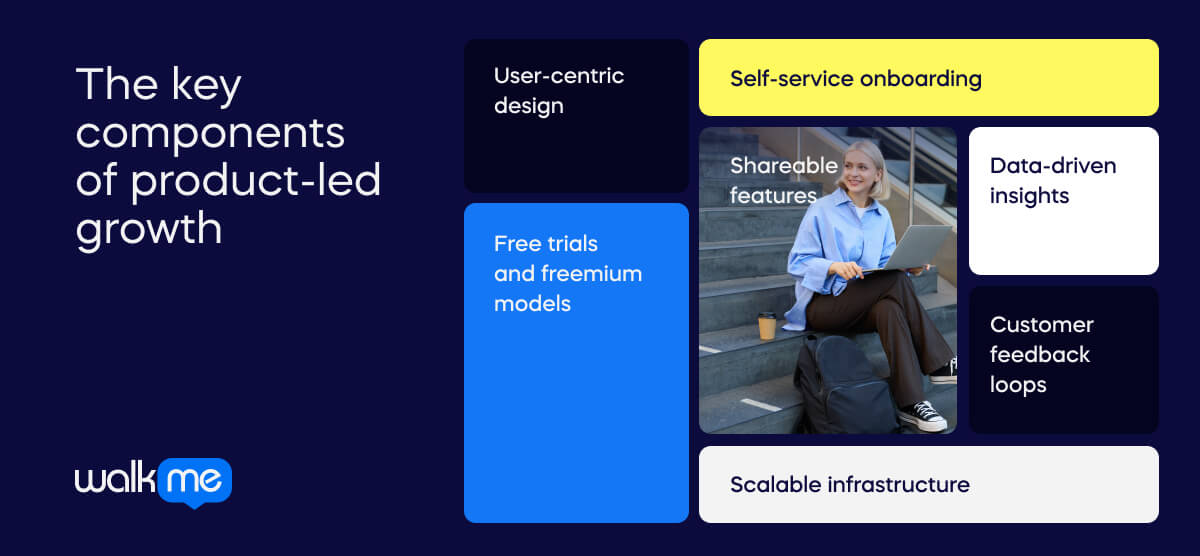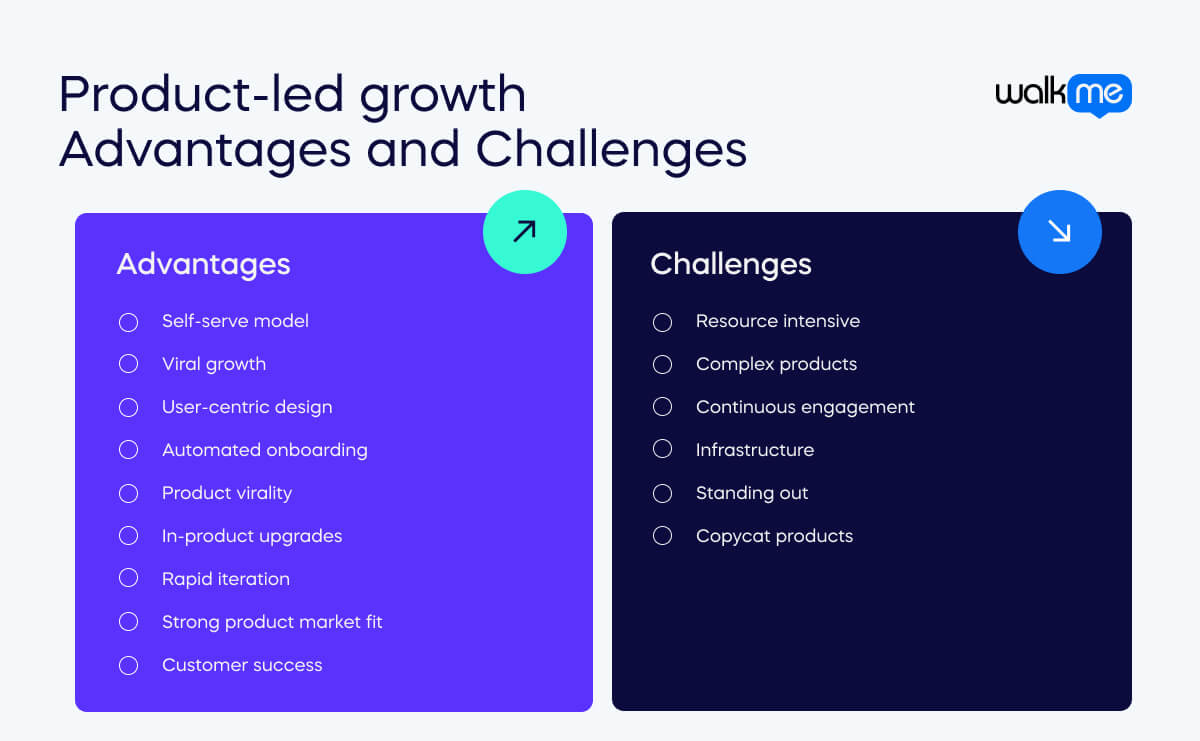Product-led growth, or PLG, is a business strategy in which the product itself attracts and keeps customers and leads to growing sales.
Companies focus on creating a valuable product that attracts and retains customers naturally.
They do not rely heavily on traditional sales and marketing tactics; they believe a great product will naturally encourage users to adopt, use, and promote it.
Companies that use PLG will prioritize the product’s value and user experience. The product usually has a self-service model so users can easily find, try, and use it independently. This is becoming increasingly important. For example, research indicates that
66% of buyers will seek information themselves before contacting a vendor.
![stat (1)]()
PLG companies usually grow rapidly due to the quality of their products. They won’t need to invest in lots of sales and marketing. This strategy is particularly effective for software and technology companies, as they can easily share and improve the products they create.
What are the key components of product-led growth?
![the key components of product-led growth (1)]()
As mentioned, product-led growth is a unique business strategy that does not rely on sales or marketing.
That means the products will have key features designed to attract and keep users.
Furthermore, these components are also designed to provide ongoing value and a high-quality customer experience.
The key components of product-led growth (PLG) include:
User-centric design
The product is built with the end-user in mind. It is easy to use, providing an intuitive user interface and a seamless experience. As a result, users quickly understand the product and can get value from it.
Free trials and freemium models
Customers thinking about purchasing can experience the products’ value without paying at first, which encourages them to convert to paid users.
Self-service onboarding
People should be able to start using the product without much help from customer support. They can use tutorials and guides to get up to speed quickly on their own.
Shareable features
The product should provide enough value that it naturally encourages sharing. Existing users will be motivated to attract new ones through word of mouth, referrals, and built-in social features.
Data-driven insights
Companies should continuously monitor user behavior and product usage. These valuable insights can be used to make
data-driven decisions that improve and personalize the product. This is important, as an Adobe study reveals that
89% of marketers see a positive ROI when they use personalization. This concept could easily be translated into PLG strategy.
Customer feedback loops
It is important to actively seek user feedback and use it to improve the product and address pain points. When user needs are better met, more customers will adopt the product.
Scalable infrastructure
The product should be designed to handle rapid growth. As the user base grows, the company must ensure the product remains reliable and performs well.
Product-led growth vs. customer-led growth
It can be easy to confuse product-led growth with customer-led growth. However, while both strategies aim to grow a business, they have different drivers.
- PLG focuses on the product as the growth engine
- CLG centers on the customer experience and relationship
Let’s take a closer look at the key differences:
| Product led growth |
Customer led growth |
| Definition |
The product itself encourages customers to sign up and recommend the product to others, helping the user base grow. |
The business understands and fulfills customer needs, preferences, and behaviors to drive growth. |
| Focus |
Developing a product that provides a lot of value and a seamless user experience.
Success is measured by how well the product itself can attract, retain, and grow the customer base. |
Understanding the customer deeply, including their needs, pain points, and desires.
Success is measured by customer satisfaction, loyalty, and the strength of customer relationships. |
| Techniques |
- Free trials and freemium models
- Self-service onboarding
- In-product tutorials and guidance
- Data-driven product improvements
|
- Customer feedback and surveys
- Personalized marketing and communication
- Customer success and support
- Loyalty programs and rewards
|
| Goals |
To create a product that users love and can easily start using.
As a result, the business grows organically due to existing users promoting the product themselves.
The aim is to reduce reliance on traditional sales and marketing. |
To build deep, lasting relationships with customers by continuously meeting their needs and exceeding their expectations.
The aim is to foster loyalty, increase customer lifetime value, and have users recommend the company as a result. |
| Examples of use |
Slack offers a freemium model and relies on the product’s ease of use to drive growth.
Dropbox uses free storage space to attract users who share the product with others. |
Zappos is known for its exceptional customer service and customer-centric policies, which drive loyalty and advocacy.
Amazon focuses on personalized recommendations and a customer-first approach, constantly improving the customer experience based on feedback and data. |
Use cases for product-led growth
We have seen some examples of companies using product-led growth at the moment.
However, it can be useful to examine PLG in more depth to understand how it can be used in many different industries.
Below, you can explore three scenarios in which PLG is used to maximize product value and user experience to acquire, retain, and expand the user base.
SaaS (Software as a Service)
- Slack offers a freemium model where users can start using the basic version of the product for free.
- The platform’s intuitive design and seamless collaboration features encourage teams to use it more.
- As teams grow, their needs become more complex. They naturally upgrade to paid plans for more features, including enhanced security, larger storage, and advanced integrations.
- Slack also includes in-product prompts and tutorials that help users discover new features, driving deeper engagement and usage.
Consumer technology
- Dropbox initially provides users with a limited amount of free cloud storage.
- As users begin to store more files and share documents with others, they often exceed the free storage limit and are encouraged to upgrade to paid plans.
- Dropbox’s user-friendly interface and seamless syncing across devices make it easy for users to integrate the product into their daily routines.
- The product’s built-in sharing features also promote virality. Users invite others to view or collaborate on files, expanding Dropbox’s user base.
E-commerce
- Shopify offers a free trial that allows potential customers to set up and start running an online store without any initial cost.
- This hands-on experience lets users understand the value of Shopify’s comprehensive e-commerce platform.
- Once users see the benefits of using Shopify to manage their online stores, they are more likely to convert to paying customers.
- Shopify also continuously improves its products based on user feedback and usage data. By ensuring it meets the evolving needs of its merchants, it drives retention and expansion within its user base.
![Product-led growth Advantages and Challenges (1)]()
What are the advantages of product-led growth?
Product-led growth is an attractive strategy for many modern businesses, particularly those in the software and technology sectors.
It offers several advantages for businesses, contributing to sustainable and scalable growth. Here are some key benefits:
Self-serve model
Users can discover, try, and adopt the product independently, reducing the need for extensive sales and marketing efforts.
Viral growth
Satisfied users naturally promote the product through word-of-mouth and referrals, driving organic growth without additional marketing spend.
User-centric design
Products that are easy to use and provide significant value encourage users to continue using them.
Automated onboarding
Efficient self-service onboarding processes allow the business to scale rapidly without needing more customer support or sales staff.
Product virality
Built-in sharing and collaboration features can increase the user base as current users invite others.
In-product upgrades
Users can easily discover and purchase additional features or higher-tier plans as their needs grow, driving revenue growth.
Rapid iteration
Focusing on continuous product improvement allows businesses to stay ahead of competitors by quickly adapting to market changes and user feedback.
Strong product market fit
Constantly refining the product to meet user needs helps achieve a better product-market fit, making the product more appealing to potential customers.
Customer success
The business’s success is closely tied to the success and satisfaction of its users, fostering a customer-centric culture.
What are the challenges of product-led growth?
While product-led growth (PLG) offers numerous advantages, it also presents several challenges that companies must address to succeed.
Tackling these issues requires a strategic approach, strong leadership, and a commitment to continuous improvement.
Resource intensive
Developing a product that provides significant value and an excellent user experience requires substantial investment in research, design, and development.
Complex products
It can be difficult to ensure users can easily onboard and understand the value of complex products, requiring effective in-product tutorials and guidance.
Continuous engagement
Keeping users engaged over time requires constant product updates and improvements, as well as ongoing customer support.
Infrastructure
As the user base grows, the product and its supporting infrastructure must scale efficiently, which can require significant technical expertise and resources.
Standing out
Creating a product that stands out and clearly demonstrates its unique value in a crowded market can be challenging.
Copycat products
Success in PLG can attract competitors who may try to replicate the product. Businesses need to improve to maintain a competitive edge continuously.
How can DAPs help with product-led growth?
Digital adoption platforms (DAPs) can significantly enhance product-led growth (PLG) by improving
user experience, driving engagement, and helping adopt new features.
By integrating a digital adoption platform, companies can ensure that their products are adopted quickly, effectively, and continuously used to their full potential.
Here are several ways DAPs contribute to PLG:
Streamlined onboarding
Interactive guides: DAPs provide step-by-step,
interactive tutorials that help new users quickly understand how to use the product, reducing the learning curve and increasing initial satisfaction.
In-product tours: Guided tours within the application highlight key features and functionalities, ensuring users can navigate the product effectively from the start.
Enhanced user engagement
Contextual assistance: DAPs offer contextual help, such as
tooltips and on-demand support, which assists users as they encounter new features or complex tasks.
Task automation:
Automation of repetitive tasks through the DAP can streamline workflows, making the product more efficient and enjoyable to use.
Data-driven insights
User analytics: DAPs collect data on how users interact with the product, providing valuable insights into user behavior, pain points, and feature usage. This data can inform product improvements and marketing strategies.
Improved user support
Self-service help centers: Integrated self-service resources, such as FAQs and knowledge bases, empower users to resolve issues independently.
Real-time support: Chatbots or virtual assistants within the DAP can provide immediate assistance.
Reduction in churn
Proactive engagement: By identifying and addressing user pain points early through in-product support and guidance, DAPs can help reduce churn rates.
Feedback loops: DAPs can facilitate the
collection of user feedback, allowing companies to make timely improvements and demonstrate responsiveness to user needs.
 PLG companies usually grow rapidly due to the quality of their products. They won’t need to invest in lots of sales and marketing. This strategy is particularly effective for software and technology companies, as they can easily share and improve the products they create.
PLG companies usually grow rapidly due to the quality of their products. They won’t need to invest in lots of sales and marketing. This strategy is particularly effective for software and technology companies, as they can easily share and improve the products they create.
 As mentioned, product-led growth is a unique business strategy that does not rely on sales or marketing.
That means the products will have key features designed to attract and keep users.
Furthermore, these components are also designed to provide ongoing value and a high-quality customer experience.
The key components of product-led growth (PLG) include:
As mentioned, product-led growth is a unique business strategy that does not rely on sales or marketing.
That means the products will have key features designed to attract and keep users.
Furthermore, these components are also designed to provide ongoing value and a high-quality customer experience.
The key components of product-led growth (PLG) include:

